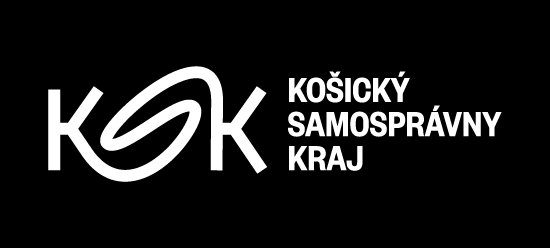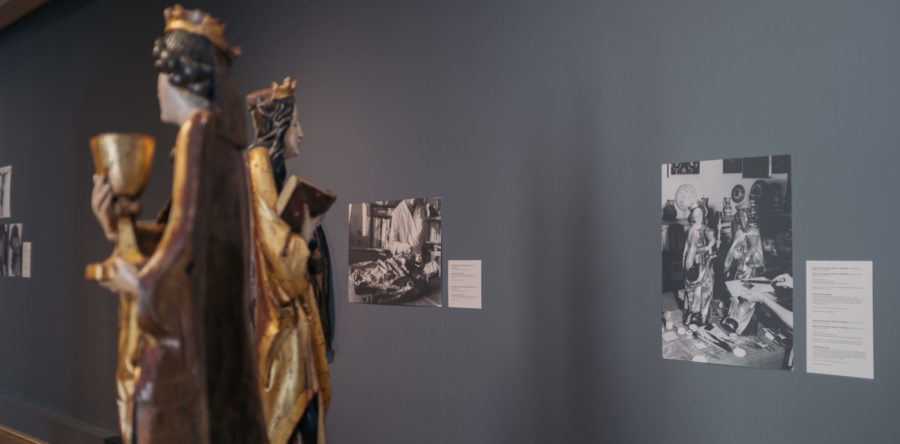duration: 19. 5. 2017 – 3. 9. 2017
curator: Katarína Nádaská
East Slovak Gallery, Hlavná 27
photo: Ondrej Rychnavský
The work of Mária Spoločníková (*1926, Košice) belongs to the most significant chapters of Slovak history of art and art restoration. On the occasion of her 90th birthday, as well as the occasion of the Year of Master Paul of Levoča, the East Slovakian Gallery presents an exhibition project dedicated to the life and work of a significant art restorer with a focus on her contribution to the survey of artworks of Master Paul of Levoča.
Mária Spoločníková has exhibited her vast restoration work numerous times. The current exhibition presents her work in a new context and appreciates her contribution to collecting institutions. One of its aims is also to include a didactic function. The exhibition presents the most significant artworks of the Gothic period, as well as some less known works of art, while both equally serve as a proof of the high quality of her restoration work. The central position is held by the artworks of Master Paul of Levoča from the early 16th century. The core of the exhibition represents The Crucified sculpture from the Church of St. Nicholas in Prešov, one of the masterpieces of his artistic work. At the same time, this piece also serves as a valuable example of the versatility of Master Paul’s work from around the Košice region.
The exhibition has an intimate character. The exhibited works of art represent Mária Spoločníková’s work in three separate units – as an Art Restorer, Woman and a Native of Košice. Each unit represents a distinctive restoration intervention, as captured within the individual artwork and in the documentation of the restoration of these works of art. The exhibition also includes an installation at St. Elisabeth’s Cathedral, which introduces visitors to Mária Spoločníková’s restoration work for the cathedral. The exhibition offers three different perspectives on a work of art – artwork at an art restorer’s studio, artwork at the exhibition hall and artwork located at its original site.
A didactic accent to the exhibition is presented through the interactive exhibit of the Madonna of Ruskinovce, the haptic facsimiles with descriptions in Braille, the model of the Madonna of Banská Bystrica by Master Paul of Levoča and the audio recording of an interview with Mária Spoločníková.
Mária Spoločníková belongs to the first generation of professional art restorers in Slovakia. She was among the first-year students of the Art Restoration Department at the Academy of Fine Arts and Design in Bratislava. Her generation (Irena Mesárošová, Vladimír Úradníček, Andrej Kuc, Dorota Filová and others) filled in the blank space within the field of professional art restoration of historical monuments in Slovakia. In the mid-20th century, a great number of monuments were in an alarming condition. During this period, a professional monument care in Slovakia was just being established. It was a nascent period of extensive restorations at various locations with focus on Medieval artworks.
Mária Spoločníková was also part of this movement and she was entrusted with the restoration of many significant Gothic artefacts in Slovakia. The situation back then presented Spoločníková with a professional challenge that she readily accepted and, which formed her approach to the restoration of Old Art. The demands of the period were, therefore, associated with her decision to protect and revive endangered pieces of Gothic art.
From the end of the 1950s, Mária Spoločníková’s work was characterized by a relatively quick succession of crucial restoration work. The peak of her career was the restoration of artworks by Master Paul of Levoča. Some of her restoration works either confirmed or proved Master Paul’s authorship. She did not pursue the career of an art restorer simply because it provided her with professional fulfilment and support, but because she perceived it as a pursuit of Good.
Mária Spoločníková is an art restorer, who, apart from the quality of her restoration work and the great number of realizations, was also active in publication work and has greatly contributed to the theory of art history.
The exhibition continues with an installation in St. Elisabeth’s Cathedral.
The Art Restorer
As a restorer of art, Mária Spoločníková was interested in the domain of Old Art, primarily in the art of the Gothic period. The selection of artistic works in ‘The Art Restorer’ section presents various art forms (panel and wall painting, canvas painting and sculpture), significant locations (Spiš and Šariš), authors (Master Paul of Levoča, unknown medieval masters or Hungarian and European painters) and fundamental collections (collections from museums, galleries and religious institutions) that are the best representatives of Mária Spoločníková’s work.
The initial step towards the restoration of medieval artworks was taken during her diploma work supervised by prof. Karel Veselý, which received the ‘summa cum laude’ honour. From her school years forward, she was engaged in the restoration of collector’s pieces coming from the growing collections of museums and galleries. The most frequent provenance of the major restored artworks were churches, which employed the artefacts in their liturgical services. Mária Spoločníková has carried out the restoration of every kind of artistic medium with the exception of artworks on paper that evoked only marginal interest.
The Crucified by Master Paul of Levoča represents the peak of the Medieval art in Slovakia. It also functions as a symbolic peak in Mária Spoločníková’s restoration career. She discussed the artwork in a specialized study published in Ars magazine (1982) as well as in her last publication Corpus Christi (2012) that brought forward its crucial position.
The Woman
The interesting selection of works of art is a result of the exploration of Mária Spoločníková’s life and work through the motif of a woman in sacral art. Woman as the determining figure of the portrayed motif inspires the varied processing of topics and leads us through the art of the Gothic period, the art of icons and folk art of the 18th century through to the art paintings of the 20th century. This selection of artworks restored by Mária Spoločníková reflects the style diversity of her work and they introduce the various techniques and methods employed in art restoration.
The emphasis on the most significant works of art (pieces by Master Paul of Levoča, a panel painting from Spišské Podhradie or the Madonna of Ruskinovice) intermingles with artworks of lower artistic category, which, however, equally serve as a proof of quality of restoration work. The selection also documents the character of the art restorer’s daily tasks.
The interconnection of sacredness with the topic of a woman reflects Mária Spoločníková’s relationship with fine art. She perceives the works of sacral art as documents capturing Christian thought as a substance filled with a valuable spiritual content. She, herself, has stated about sacral art: “Substance is the bearer of spirituality.”
The Native of Košice
The High Altar of St. Elisabeth at St. Elisabeth’s Cathedral in Košice is one of the most significant altarpieces coming from the late Gothic period in Slovakia.
It is one of Mária Spoločníková’s most significant restoration works. Ever since she was a child, she perceived and knew the altar well. According to her words, it ignited her childhood imagination and joy while watching “the beautiful lady with a doll”. It was the first work of Medieval art that she worked on, whilst still a student of Art Restoration. Through this artwork, she began to recognize the importance of the preservation of Old Art that finally set the direction of her life.
In 1950, she started to help with the restoration of the altar wings as a part of a student group supervised by prof. Veselý. In 1988 – 1995, she already worked as an established art restorer on the final complex renovation of the high altar. She carried out the restoration of the altar statues of the Madonna and St. Elizabeth of Hungary, as well as the panel paintings from the altar wings.
During WWII, the altar was dismantled and stored at a bishop's residence in Hejce (Hungary). It was returned in 1945 in a heavily damaged condition. It was stored in crates, which were delivered to the north nave of the cathedral. The restoration of the altar was subsequently initiated in 1947 and completed in 1964. During this period, Mária Spoločníková became one of the last eyewitnesses of the appearance of the two no longer existing medieval altars from the cathedral (The Lord’s Supper and the Dormition of the Virgin Mary).
The final complex restoration of the high altar carried out in 1988 – 1995 was a demanding task, which was undertaken by several teams of art restorers. The altar was initially dismantled in 1986 and subsequently gradually restored.




